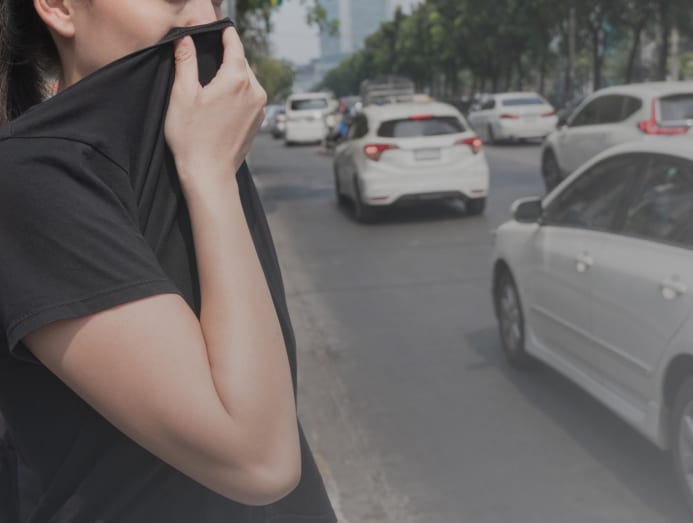How dirty are the clothes you wear outside? Should you shower and change immediately after reaching home?
With experts warning about the haze returning to Singapore, you could be "wearing" more air pollutants on your clothes and bringing them home with you. But should you be showering and changing out of your outside clothes every time you come home?

Do you head for the shower immediately after stepping through the door? (Photo: iStock/yamasan)
You know how it is. You come home from a long day’s work, mentally exhausted and maybe a little emotionally bruised. You just want to crawl under your duvet and let your bed and the familiar cosiness of your room envelope you.
But before you can even approach your sanctuary, your mum or partner yells out: Change out of your clothes first! Don't wear your stinky, sweaty workwear to bed!
But come on, is your family over-reacting by insisting you get out of your outside clothes each time you come home? Is it all that necessary if it’s just a short trip downstairs to check the letter box or to buy teh tarik from the nearby coffeeshop? Hear what the experts have to say before you flop onto your bed.
WHAT’S IN THE AIR AROUND YOU?
Well, there is the “severe haze” to think about after all, no thanks to the hotter and drier conditions that the experts have predicted for June to October this year. You can, in general, expect more visible pollutants such as dust, dirt, soot and smoke as well as invisible ones settling on your clothes.

Visible pollutants such as fumes from exhaust pipes, dust stirred up by the wind or soot from fires are one aspect of air pollution. Then, there are the invisible pollutants that the National Environment Agency (NEA) monitors: Fine particulate matter (PM2.5), sulphur dioxide, nitrogen dioxide, ozone and carbon monoxide. Their concentrations (with the exception of PM2.5, which is measured hourly) are recorded to provide the 24-hourly Pollutant Standards Index or PSI readings that you often hear in the news.
And that’s not mentioning the volatile organic compounds (VOCs) or chemicals you’re exposed to each time you walk into a freshly cleaned public bathroom or get into your Grab ride, said Dr Lim Keng Hua, an otorhinolaryngologist from Mount Elizabeth Hospital. That fresh smell you associate with a sanitised environment? Those are VOCs you’re inhaling.
What you’ve read so far are some examples of abiotic factors that could settle onto your clothes on a daily basis, said Associate Professor Yu Liya from National University of Singapore’s Department of Civil and Environmental Engineering at the College of Design and Engineering. There are also biotic ones that include bacteria, viruses, mould and fungi, she said.
The common micro-organisms found on textile are likely to belong to the staphylococcus and micrococcus groups of bacteria, said Dr Shawn Vasoo, the clinical director of National Centre for Infectious Diseases. Interestingly, these bugs are usually part of your skin's microbiome.

If you often give your bra, jeans or jacket a few rounds of wear before they go into the washer, you could also be wearing mould and fungi as they proliferate in our humid environment, said Dr Lim.
WHAT ARE THE POLLUTANTS’ EFFECTS ON HEALTH?
“The tiny particles suspended in the air, such as dust, pollen, soot and vehicle emissions, can settle on your clothes and cause respiratory irritation, allergies or exacerbate existing respiratory conditions,” said Dr Lim.
As for the invisible gases such as sulphur dioxide, nitrogen dioxide, ozone and carbon monoxide you could be inhaling, they may lead to eye irritation, affect respiratory health, or cause fatigue, dizziness or headaches.
But the key concern, according to NEA, is the PM2.5 level as the fine particles it measures can affect the heart and lungs, especially in those who already have chronic heart or lung disease such as asthma, chronic obstructive pulmonary disease or heart failure. In healthy individuals, particulate matter may irritate the eyes, nose and throat, noted NEA's website.
What about the staphylococcus and micrococcus (they can cause infections when they enter the body through cuts in the skin) found on textiles? Dr Vasoo said that they "do not typically cause disease". But if someone is colonised with certain resistant bacteria, he may shed them on his clothes and into the environment.
Fortunately, such colonisation does not lead to disease in most cases, even for the SARS-CoV-2 virus that causes COVID-19, said Dr Vasoo. "Outside of an environment that does not pose a higher-than-normal risk of exposure to micro-organisms (such as healthcare, environmental hygiene/sewage or waste management), the risk to the average person would be low."
And the mould and fungal spores? They can lead to respiratory issues, allergies or even infections in susceptible individuals, said Dr Lim. “This explains why fungal infection of the ear is relatively common in my practice. Many patients have fungal spores growing in the ear canal, especially when their ears have been exposed to moisture.”
WHAT CAN YOU POTENTIALLY BRING HOME?
It depends on the environment you were in and the duration of your activity, said Assoc Prof Yu. “Individual microenvironments can have very different concentrations and compositions of airborne components. Generally, confined environments with limited ventilation and crowds tend to have more airborne pollutants.”
For instance, the accumulation of airborne contaminants may be higher in a confined space such as a bus or MRT, or in crowded places such as the shopping mall or market, said Dr Lim.
“Food courts or hawker centres can also release cooking fumes, which may contain particulate matter and odorous substances that can cling to clothing,” he added.
Exercising outdoors doesn’t exempt you from pollutants either. There are vehicle emissions and industrial pollutants, and even nature can contribute with pollen that can trigger allergic reactions, said Dr Lim.
Your body is another source of emissions, said Assoc Prof Yu. “Human beings shed lots of skin daily – on average, about 0.7 kg per year – a reason why regularly changing clothes and bedlinen is needed for maintaining good personal hygiene.”

Now, imagine taking all the dead skin, dust, bacteria, viruses, pollen and other contaminants your clothes have come into contact with throughout the day – and scattering them all over your bedsheets. That’s what you’re doing when you lie down without changing out of your clothes at the end of a long day's work.
“Over time, this can contribute to the buildup of allergens and other undesirable substances on the bedding, potentially impacting our comfort and hygiene during sleep,” said Dr Lim. “Regularly changing into clean sleepwear or changing out of outside clothes can help minimise this transfer and maintain cleaner bedsheets.”
WHAT CAN YOU DO?
Even though you’re likely to be accessorising your work outfit with pollutants at the end of the work day, it is “not necessary for everyone to shower and change clothes immediately upon arriving home”, said Dr Lim. But there are situations – like after getting out of a crowded bus or MRT during peak hours, or after a visit to a healthcare facility – when it doesn’t hurt to step into the shower first when you get home.
Shower and change up, too, if you have allergies, respiratory conditions or a compromised immune system to minimise the risk of triggering symptoms or exacerbating your condition, said Dr Lim. “This can be especially relevant if you have been in environments where allergens or irritants are prevalent.”

But if clothes do play a part in accumulating pollutants, would covering less of your body’s surface area such as opting for sleeveless tops, shorts or even going topless for men help to reduce the amount of pollutants you accumulate? No, your best bet is to “shield yourself with a layer of clothing to reduce exposure and wear clean clothes”, said Assoc Prof Yu. “We can consider a function of clothes as a protection layer.”
She cited a study which found that freshly cleaned clothes reduced the exposure to some pollutants. However, “Continually wearing clothes with an accumulation of adsorbed pollutants can impose higher probability of contact with pollutants,” she said.
What about those short trips to collect mail or quick errand runs? "I don’t think it’s necessary to shower and change out of your clothes when you are just doing normal activities," said Dr Vasoo. "This would probably be excessive in my opinion."
Still, it is a good habit to wash your hands thoroughly with soap and water or use a hand sanitiser after being in public spaces, said Dr Lim.

Also, don’t go overboard by scrubbing yourself raw with antibacterial soap or insisting on doing laundry immediately. “Studies have shown that it is unhealthy living in a ‘too clean’ environment,” said Assoc Prof Yu. Instead, “building and maintaining one’s immunity is a good and feasible approach to deal with airborne components in various environments”.
Moreover, showering and changing out of your outside clothes “cannot completely eliminate all external pollutants or microorganisms”, said Dr Lim, as “some contaminants can still be present on the body or in the respiratory tract”. “Other hygiene practices such as regular cleaning and ventilation are also important for maintaining good indoor air quality.”
All the experts agree that washing your clothes and bedlinen with detergent and water at 60 degrees Celsius will do the job. But they differed in their opinions when it comes to how often you should change your bedsheets.
Dr Vasoo said that "changing bedsheets regularly is probably more important to decrease allergens such as house dust mites". Meanwhile, Dr Lim suggested doing it every one or two weeks to "remove sweat, body oils, dead skin cells, and any external contaminants that may have accumulated”.
One thing's for sure, it's time to take that air purifier out of the storeroom when the haze hits.







